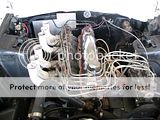73GreenMachine
Well-known member
So after a year or so it finally runs, although I can't seem to get good power from the setup.
Specs are:
Ported Aluminium Head with 220cfm@0.550 intake (28"H2O) (over 330hp potential) and 165cfm exhaust, 11.2:1 compression
custom hydraulic cam 285/292 (230/237@0.050) 0.510/0.530 lift, 112LSA
Twin Impco 225 mixers (329cfm@1.5"Hg each) running sidedraught on a custom intake manifold.
250ci crank and 200ci rods with custom ACL pistons,
Balanced and blueprinted
Ford EF Falcon 12 counterweight crankshaft
Main stud girdle and ARP bolts throughout
Megajolt programmable crank fired ignition system
Timing was 28 degrees total
This combination made 240hp@5200rpm at the flywheel with 280 lb/ft flat around 3500rpm. Torque seemed to be healthy and come on quite early, on a good run it was making 260lb/ft right from the start of the dyno pull at 2700rpm.
Needless to say I was expecting to get a bit more out of a setup like this , now the head and bottom end seem to be overkill for the horsepower being generated.
So the question is, is it the cam that is letting things down (ie not being suited to LPG) and if so, are there any suggestions to help fix it?
Specs are:
Ported Aluminium Head with 220cfm@0.550 intake (28"H2O) (over 330hp potential) and 165cfm exhaust, 11.2:1 compression
custom hydraulic cam 285/292 (230/237@0.050) 0.510/0.530 lift, 112LSA
Twin Impco 225 mixers (329cfm@1.5"Hg each) running sidedraught on a custom intake manifold.
250ci crank and 200ci rods with custom ACL pistons,
Balanced and blueprinted
Ford EF Falcon 12 counterweight crankshaft
Main stud girdle and ARP bolts throughout
Megajolt programmable crank fired ignition system
Timing was 28 degrees total
This combination made 240hp@5200rpm at the flywheel with 280 lb/ft flat around 3500rpm. Torque seemed to be healthy and come on quite early, on a good run it was making 260lb/ft right from the start of the dyno pull at 2700rpm.
Needless to say I was expecting to get a bit more out of a setup like this , now the head and bottom end seem to be overkill for the horsepower being generated.
So the question is, is it the cam that is letting things down (ie not being suited to LPG) and if so, are there any suggestions to help fix it?









